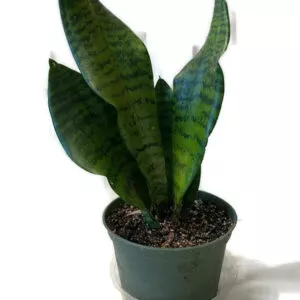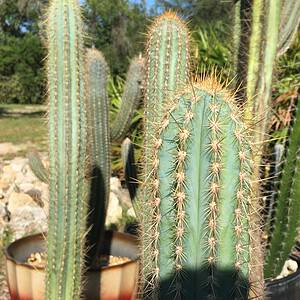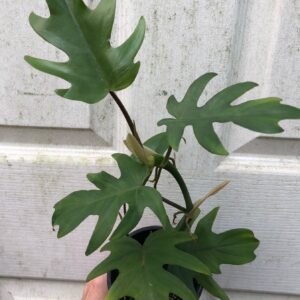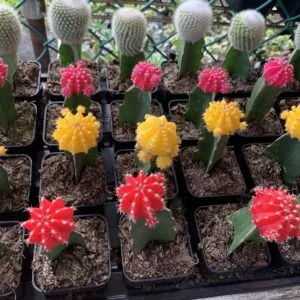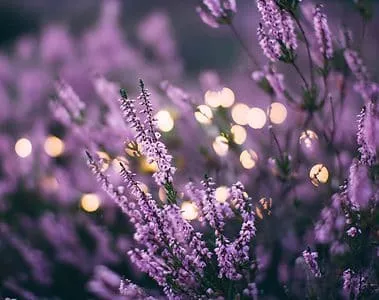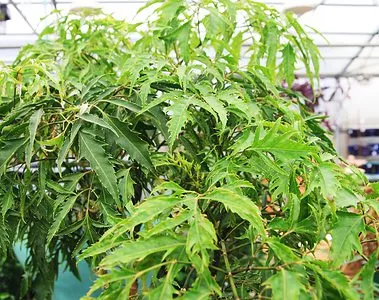No products in the cart.
Table of Contents
How awesome is the plant so impressive with its spearlike leaves? Do you agree? Do you want to own the Sansevieria cylindrica? If you stay longer, you can learn how to care for it.
The best part is it is a low-maintenance yet unusual plant you can grow in your garden or home. The exotic plant also goes by many names but a bit more later on them. Still, you can sit and look at those leaves magnetized the whole day.
What are African Spear Plants
The fascinating thing is the Sansevieria cylindrica has many names. For example, some gardeners call them the African spear plants. While other botanists call it the cylindrical snake plant, spear orchid, and starfish Sansevieria, the exciting thing is we have never displayed such a rare plant that is an Angola succulent native.
The succulent is an evergreen perennial that grows in dense wild sand. The spear Sansevieria has creeping rhizomes underneath the soil and can easily handle neglect. Now, we are not saying you should disrepair it.
On the contrary, the hallmark of this African plant is the cylindrical leaves that are smooth in dark green with a green-grey spectrum.
Another highlight is that this plant flowers a cream-white flower spike when it matures with a light fragrance but is not very showy. Oh yes, and common practice to braid the stalks with ropes together at the top allowing for controlled growth.
But to do this, you must ensure the stalks are short.
Cylindrical Snake Plant Care Basics

This is one tough cookie to care for as it can endure extreme conditions. But if you want your cylindrical snake plant to look elegant, follow the helpful tips provided here.
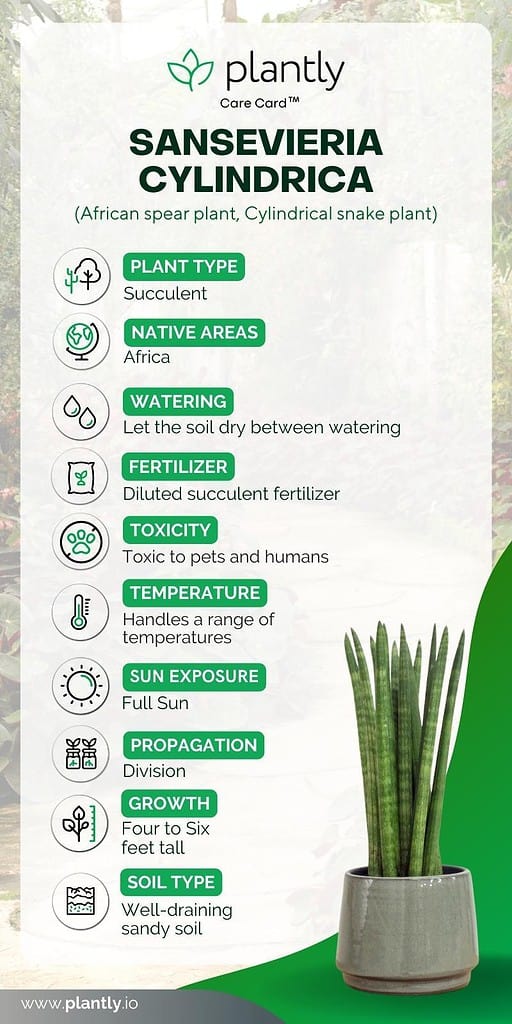
Best Potting Mix
While some gardeners refer to Sansevieria cylindrica as a snake plant, it is not a Dracaena trifasciata. Instead, it is a succulent plant that needs the same soil as snake plants.
Plant Sansevieria cylindrica in a succulent mixed soil that drains well. The ground needs to be loose such as sand. So, you can opt for sandy soil and add some organic matter to it to drain well and prevent root rot.
Or you can choose a succulent soil mix with some peat added. Another thing your succulent plant is not fussy about is the pH levels.
Lighting Conditions

Now, gardeners do not go and place your Sansevieria in intense light as they do not like the full sun. In contrast, they love sunbathing to ensure proper growth.
The harsh midday to afternoon sun burns those gorgeous leaves when you grow Sansevieria as indoor plants position them near your north-facing window.
Or you can place your plants in a spot where they can get four to six hours of direct sunlight to partial shade is ideal. Unfortunately, while it can handle low light, the leaves do not have a vibrant color.
The same applies to growing them as an outdoor plant. Your plants need morning sun but need protection from bright light in the afternoon. You do not want them to turn yellow at the edges of the leaves.
Watering
You do not want your plant sitting in wet soil as an Angola succulent is native to high temperatures and humidity—instead, water sparingly by leaving the ground to dry between watering.
With well-draining soil, it allows for the right amount of moisture to nourish your plant. Still, keep an eye on the potting medium when scorching, as it will need more watering.
Depending on the potting medium used, you can reduce the water to once a month during winter. For example, a terracotta pot allows the water to dry out faster.
So it will help retain water and allow the soil to dry out between watering. Another great option is to invest in a soil water meter instead of using your fingers.
Temperature & Humidity

How to grow Sansevieria cylindrica at the right temperature and humidity is not too difficult. Your plant is hardy and handles different temperatures from 50°F to 85°F
Your cylindrica Sansevieria does not like temperatures below 50°F (10°C). When the temperature drops or gets too cold from outdoor frost or air conditioners, it can kill your plant.
Also, your plants can handle high humidity, but it is not an essential part of their growth. If you have your greenery in high humidity, you must ensure the ground is parched before watering.
Fertilizing Your Plant
When it comes to Sansevieria cylindrica care, it is a light feeder. Keeping your greenery happy helps to provide them with organic nutritional soil. You can use a half-strength diluted succulent fertilizer (10-10-10). Also, stop feeding your plant in the winter months.
Propagation
Luckily, you can propagate your Sansevieria genus in several ways as it matures. First, while it is a slow-growing succulent, it creates offsets known as pups.
The pups develop rhizomes that have their root system when a bit more mature. So you can easily separate it from the mature plants. Once divided, you can pot them in a container with enough drainage holes and the right potting mixture.
Also, keep them out of cold temperatures and do not wet them too much, leaving them with soggy soil. Within a season, you will see them multiplying with their underground rhizomes.
You can also grow your plant from leaf cuttings planted upright. Still, it is a challenging yet time-consuming process. Botanists recommend this technique using a sharp knife if you want a vast number of plants.

Growth Zone
The plant you can grow in the USDA hardiness zones 10b to 11b. But it is recommended to bring your plant inside when it gets too cold.

Potting Your African Spear
When you require repotting for your skyline spear, drainage is essential. You can place a few pebbles at the base of the container.
Use the recommended ground to provide your elephant’s toothpick with its nutrients. As a slow grower, you need not replant your succulent often and the best time to transplant them is in spring.
Providing your plant with fresh soil is a great thing as the old soil has lost its nutritional value with time.
Sansevieria Varieties
Below are snake plant varieties that are similar to Sansevieria Cylindrica.
Saint Bárbara Sword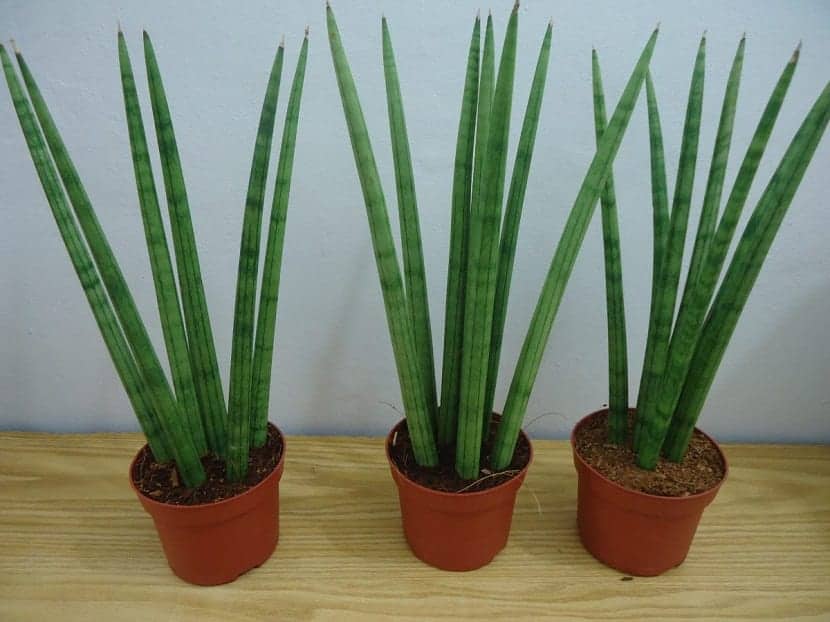
While the resemblance is similar to your African spear, this plant does not have cylindrical leaves and is also known as the snake plant. The fantastic thing is these plants have air-purifying benefits as houseplants.
Dracaena angolensis

The cylindrical snake plant resembles the skyline spear Sansevieria shape and is confused with the Sansevieria cylindrica plant. The leaves grow from a basal rosette and have stiff leaves. As with most succulents, it also needs soil drainage and blooms sporadically.
Sansevieria boncel

Compared to your African spear, this plant also has spiky leaves, but it is short and fat. The foliage grows in a fan shape, making it an attractive houseplant.
Sansevieria Cylindrica Plant Diseases & Pests
Taking care of this rare plant means looking out for fungal infections and pests. Yes, your houseplant can also become the prey of insects, as most succulents do.
The Mealybug
If you have other infected plants with mealybugs, you can expect them to travel to your exotic plant. All you need to get rid of them is a few drops of isopropyl alcohol on a cotton ball to wipe the leaves.
Spider Mites
If you encounter these tiny insects, you can rinse the leaves using warm water. Still, if the infestation is severe, using some Neem oil helps. Another great thing to use is soapy water which allows for mild infections.
Vine Weevils
While it is not a common insect, an adult weevil has a short snout with wings, and they feed at night on your plant. During the day, you find them hiding in ground cracks.
The most significant harm caused by these insects is the larvae and grubs on the roots leaving the leaves wilting even when watered. Read this exciting article from Planetnatural on how you can control them.
Scale
When left untreated, it becomes an issue, and the best treatment is using Neem oil. Yet, you will need to repeat your treatment to get them under control.
Leaf Spot
One of the few diseases that can cause havoc with your plants is leaf spot. Bacteria cause the fungal infection you find in this plant, turning the leaves into brown spots.
You need to remove the infected foliage and check that you are not over-fertilizing it. Also, make sure that the roots are not in excessively wet soil for long periods when it stands in an extra humid environment.
Make sure to remove the excess water and remove it from low light conditions and provide it with some bright sunlight. If the problem persists, you can use a fungal or bacterial treatment.
Frequently Asked Questions
Similar to your other succulents, your plant keeps the air in your home clean from impurities. Still, it is one of those rare plants that convert carbon dioxide to oxygen at night.
The good news is no it does not attract mosquitoes or other insects as it has a chemical called Saponin that repels the pesky mossie.
Brown tips on the leaves can result from underwatering or using over-chlorinated water. Another cause can result from too much bright light or the high temperature.
The African Spear plant bloom sporadically outdoors but seldom flowers indoors.
The plant is mildly toxic and can cause stomach upset when consumed, and best to keep it away from pets and children.
The Sansevieria plants can reach up to six feet tall and two feet wide.
Whether you want to buy, sell, or simply reach out to other plant enthusiasts, Plantly is the right place to be!
-
$17.95Sold By: Orchid Stuff Plus
$23.95In stock
Stunning Snake Plant Sansevieria Zeylanica in a 6 inch pot!
Only 2 available and it’s in 1 people’s basketRated 5.00 out of 5 based on 1 customer rating00Sold By: Orchid Stuff Plus -
-
$25.95Sold By: SunSoul Plants
$42.95In stock
Philodendron Mayoi Plant in 4″ pot, philodendron Tahiti
Rated 4.87 out of 5 based on 98 customer ratings00Sold By: SunSoul Plants -
$29.99Sold By: BubbleBlooms
In stock
Grafted Moon Cactus / Ruby Ball Cactus Set of 4 different colors
Rated 4.81 out of 5 based on 279 customer ratings00Sold By: BubbleBlooms
